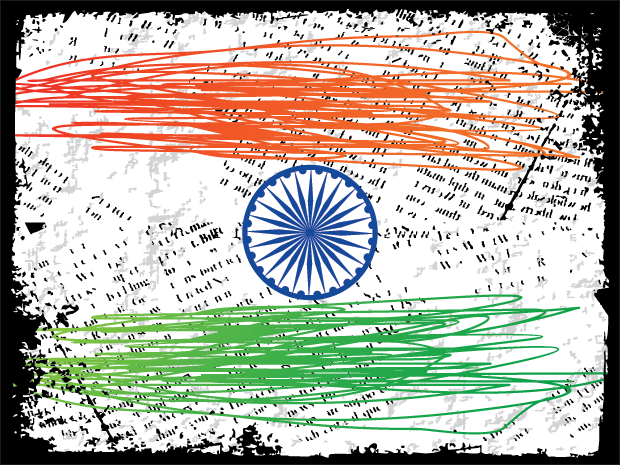13 Feb 2014 | India, News, Politics and Society
 The Indian judiciary, with its prickly ego and halo of righteousness, has always wielded the sword of “contempt” in a swashbuckling manner.
The Indian judiciary, with its prickly ego and halo of righteousness, has always wielded the sword of “contempt” in a swashbuckling manner.
In 1995, the movie Gentleman had some scenes in which judges were shown as being subservient to politicians, and susceptible to bribery. The filmmaker had two options- delete those “offending” scenes, or face prison for contempt of court. Needless to say, he settled for the former. Then in 2001, a fortnightly magazine carried out a performance evaluation of some judges of the Delhi High Court, and published a Report Card, grading them on integrity and competence. The court saw red at this “scandalising”, and slammed a sentence for conviction. Of course, the court praised itself: the judiciary was the “messiah” which protected the press and media from state interference. Meanwhile, when it comes to allegations of personal misdemeanour and malfeasance by judges, nobody needs to even petition the court. It swoops down on its own and muzzles the press.
However, this imperiousness pales in comparison to the Delhi High Court’s award of a gag order in the case of Justice Swatanter Kumar, a retired judge of the Supreme Court, accused of sexually harassing one of his female interns. The 16 January order is nothing less than a generous reward to a SLAPP suit, and worse, it also reveals a manifest bias in favour of the plaintiff, almost as if there was a concerted effort to stifle accountability.
On 30 November 2013, a former intern filed a complaint of sexual harassment against the judge, and when the Supreme Court declined to intervene, on 10 January, she took recourse to a PIL (Public Interest Litigation) before the same court. Coming right on the heels of another similar case, it made to all the front pages and television channels. Though there were some headlines which could have been phrased better, not a single paper or channel even remotely speculated on the veracity of the allegations. All they did was quote from the complainant’s petition and disclose the name of the judge. On 14 January, a phalanx of legal eagles threw their lot in with the accused judge and made a beeline for the Delhi High Court. Their vociferous assertion was tha newspapers, television channels, and the intern had colluded to tarnish the reputation of an upright judge by leveling malicious and scurrilous charges.
Two questions hit us at this juncture. One: when the petition was pending before the Supreme Court, why would the plaintiffs rush to the Delhi High Court, unless of course, forum shopping was their objective ? Two: if their beef was with the allegedly defamatory reportage, why would they also sue the intern?
Parsing the order granting an interim injunction might hint at some answers. The issue before the court was a simple one – whether the defendant newspaper and television channels’ actions amounted to trial by media and resulted in adverse publicity against the accused judge. (Un)surpringly, Justice Manmohan Singh starts by praising the judge’s sterling record on the Bench, and arrogates to itself the right to decide whether there was a smidgen of truth in the allegations. He also holds forth on the need for a statute of limitations in cases of sexual harassment. Then he cites a Supreme Court judgement which had justified prior restraint on reportage and in one fell swoop imposes a blanket ban on reporting of the case. This ban’s scope is scary- besides media houses, “any other person, entity, in print or electronic media or via internet or otherwise” were also drawn in.
Effectively, it means that no one, not even a person or a blogger not connected with the case, could write, or even tweet anything about it. When in most jurisdictions bloggers are being granted the same protection as journalists, could there be a more regressive step?
Legally India, a web portal had used a heavily pixelated image of the judge, so as to eliminate any identifying marks and carried a report totally in accordance with the court’s injunction. Despite that, the fire-and-brimstone emails it received from the plaintiff’s solicitors leave no room for doubt- that intimidating into silence is the only objective. The plaintive plea about irreparable damage to reputation is only a chimera.
A free press is indispensable for speaking truth to power, even the vast powers of the judiciary. Moreover, the Constitution of India makes it incumbent upon the judiciary to protect the press so that accountability and rule of law do not remain mere shibboleths. And when this same august institution clearly appears to champions SLAPP suits, it is indeed a mockery of the rule of law, as a livid Editors Guild said without pulling any punches.
This article was published on 13 February 2014 at indexoncensorship.org
13 Feb 2014 | Academic Freedom, Asia and Pacific, India, News

(Image: University of Chicago)
This is not a ban; it is surrender. There is no nicer way to put it. Rather than fight the case in higher courts, instead of making the case of freedom of expression and academic freedom, and avoiding the option of standing by a renowned author, Penguin has decided to throw in the towel and agreed to withdraw Wendy Doniger’s award-winning, scholarly, entertaining, and authoritative book, The Hindus: An Alternative History, and to destroy remaining copies within six months.
Doniger is the Mircea Eliade Distinguished Service Professor of the History of Religions at the University of Chicago Divinity School, and one of the foremost authorities on Hinduism. Penguin’s decision is unlikely to be based on literary merit — the book has been on sale in India since 2009 and those who wanted to, have already bought it. Now more will try to buy it through fair means or foul. And Penguin’s decision is possibly made out of expediency — perhaps to cut costs, perhaps to avoid trouble, or perhaps out of concern for the safety of its staff. None of this reflects well on Penguin or on India.
Dina Nath Batra of Shiksha Bachao Andolan Samiti had filed a suit in 2011, seeking the withdrawal of the book, saying the book was written with “a Christian missionary’s zeal” to denigrate Hinduism and show it in a poor light. For the record, Doniger is not a Christian, and even if she were that would be irrelevant — and yet in any case, Hindu nationalists have rarely let facts get in the way of their theories.
Also for the record, when the book came out in 2009, I had asked Doniger about the rise of the more militant brand of Hinduism, which has led to attacks on the works of overseas scholars, including Michael Witzel of Harvard, James Laine who wrote a book on Shivaji, and Paul Courtright who wrote one on Ganesha, and homegrown ones, like D.N. Jha, who wrote that Hindus do eat beef and there’s no religious stricture against it.
Doniger told me then that she had written her book to clear some misunderstandings about Hinduism, and “to counteract the Hindutva misinterpretations of the Ramayana”.
Last night I asked Doniger what she thought about her publisher’s decision. Deeply concerned, she told me: “Penguin has indeed given up the lawsuit, and will no longer publish the book. Of course, anyone with a computer can get the Kindle edition from Penguin, NY, and it’s probably cheaper, too. It is simply no longer possible to ban books in the age of the Internet. For that, and for all the people who have expressed outrage over this, I am deeply grateful.”
Read the rest of this article at Livemint
7 Feb 2014 | Digital Freedom, India, News

(Image: Shutterstock)
Lord Chief Justice Campbell, while introducing The Obscene Publications Act 1857, described pornography as “poison more deadly than prussic acid, strychnine or arsenic” and insisted that the law was imperative to protect women, children and the feeble-minded.
The Indian Supreme Court’s observations and directions while hearing a petition in which online pornography is blamed for of the “epidemic” of rape and sexual violence is redolent of the pornophobia which had gripped the puritanical English legal system in the Victorian era. It is also a stark reminder of the befuddling and dangerous consequences of internet filters, as is being seen in the United Kingdom.
On 27 January, one of the defendants, the Internet Service Providers Association India (ISPAI) while stating that they would not indulge in voluntary censorship, posed a more challenging question — since there is no granular distinction to be made between “high art” and pornography, since temple sculptures can simultaneously be interpreted as both divine and obscene, how could they decide what to block and what to allow. On 28 January, all liberty-loving Indians were aghast at the Supreme Court’s intransigence on homosexual sex.
Taken together, these incidents portend to consequences more pernicious than just a chilling effect on free expression. As Lynda Nead contends, drawing a distinction between sublime and profane seeks to serve a social legitimising function which result in moral policing and violations of the rights of many.
Does pornography cause rape? Justice Douglas’ statement in Ginsberg — “Censors, of course, are propelled by their own neuroses” — and Ronald Dworkin’s reply to Katherine MacKinnon’s “breathtaking hyperbole” remain the most plausible answers to date, not a single study has been able to irrefutably prove correlation, let alone causation. However, Indian courts’ treatment of pornography has been ironic because exposure to obscene and sexually explicit material has been treated as a mitigating factor in rape sentencing. Reepik Ravinder and Phul Singh are two examples of rapists being regarded as victims of the “sex explosion” on celluloid. Not only that, a “ministry of psychic health and moral values” has also been directed to be established to nip this epidemic of vulgarity in the bud.
Justice Potter Stewart’s aphorism “I know it when I see it” holds true for any “definition” of pornography — even today. All we have got is a mystifying epithetic tautology — prurient, lewd, filthy, repulsive, which does no service to the clarity of judicial vision. It is easier to treat pornography as an accused, rather than an offence, because tropes and stereotypes make for poor and unjust legal definitions.
The plea to criminalise browser histories suffers from several grave elisions. For one, irrefutable evidence of correlation, let alone causation, between pornography and sexual violence or depravity is conspicuous by its absence. Though Delhi has a high rate of reported rapes, Google Trends data from 2013 shows more people in the apparently conservative bastions of Gujarat and West Bengal were searching for pornography online.
Most significantly, an obscurantist idyll defines the average consumer and purposes of online pornography. Evidence dispels the notion of only rapacious, lustful men devouring pornography. A 2008 survey reported one in five women watching and approving of porn. Forty-five percent of women who watched pornography also made their own porn videos, and stated how it had helped them being sexually inventive and more intimate with their partners. Another survey, deemed to be the most comprehensive, shows 60 percent women and 80 percent men admitting to accessing sexually explicit content online. Significantly, 30 percent of women respondents said that such content deals with sexual and reproductive health and romance, too. More significant is the response that usage of pornography improved couples’ sex lives.
Moreover, the upshots of dragnet internet filters are reasons for grave consternation. Google AdSense mistook an author’s memoir for pornography and blocked it. In reverse irony, smut sites got caught in an attempt to prevent bureaucrats from surfing sites related to the stock market. And since algorithms do not have a mind of their own, Christopher Hitchens’s polemic against Mother Teresa “The Missionary Position” might also lose its immunity.
India’s information technology law remains riddled with fuzzy definitions, and right now Google, stands indicted for defamation. A ban on internet pornography would further queer the pitch for intermediary liability, thereby delivering another blow to free speech.
Given the climate of legal homophobia, a reference to the aftermath of Canada’s ban on pornography becomes pertinent. There was a sustained persecution of bookstores stocking gay and lesbian literature, comics included, and 70 percent of prosecutions were of homosexual pornography. Besides, even if there were only opt-in filters, it would entail identifying one’s sexual preferences. And where demands for arresting homosexuals are raised on the flimsiest of pretexts, one would become a sitting duck for privacy breaches and criminal prosecution.
One can only wish these apprehensions, and not pornophobia, inform the Supreme Court’s decision.
This article was posted on February 7 2014 at indexoncensorship.org
31 Jan 2014 | Digital Freedom, India, News, Politics and Society

(Image: Sergey Nivens/Shutterstock)
In 2009 India announced its grand universal biometric scheme “Aadhaar”. The scheme, managed by the Unique Identification Authority of India (UIDAI), collects the fingerprints, iris scans and facial images of applicants in exchange for a national identification number. First handed out in 2010 the numbers, randomised 12-digit codes, function as “internal passports” which can be used as proof of identity to access state services.
November 2013 marked 500 million enrolments to the scheme, making Aadhaar the largest biometric programme in the world. This year the scheme is set to be linked to major development reforms, and the collection of data, stored in a centrally controlled database, aims to improve transparency, reduce corruption and ensure access to the country’s myriad of welfare benefits.
India’s welfare state is characterised by “leakage”: by corrupt middlemen syphoning off benefits and claimants taking more than their share. The biometric scheme plays an important role in making sure that those who are entitled state aid receive it. But despite this developmental progress India lacks comprehensive protections for biometric data, raising serious concerns about individual privacy.
A report by Oxford Pro Bono Publico, a research centre affiliated to the University of Oxford, found India’s controls over the collection, storage and use of biometric data, compared to other jurisdictions, hugely deficient.
The sheer scale of the project compounds concerns, with UIDAI aiming to enrol every one of India’s 1.2 billion people. The scheme was first introduced as voluntary, but as more and more development schemes are administered through it, welfare recipients seeking state aid have little choice but to hand over their data.
Justice Puttaswamy, a retired High Court judge, has led the charge in challenging the scheme on privacy grounds. As he argued in his petition to the Indian Supreme Court, “there are no safeguards or penalties and no legislative backing for obtaining personal information”. His complaint culminated in a Supreme Court interim order, which insisted that the scheme must remain voluntary and that those entitled to receive welfare should do so regardless of their Aadhaar status.
Attempts to circumvent the Aadhaar programme to deliver benefits, however, have become increasingly difficult. Last year, despite the Supreme Court order, reports emerged from Delhi that food-subsidy ration cards were only being handed out to those with national identification numbers. A recent announcement by the Minister for Food and Civil Supplies, that consumers without Aadhaar cards would continue to receive discounted cooking gas, provoked oil companies and the Union Ministry of Petroleum and Natural Gas to return to the Supreme Court to file an appeal.
Aadhaar was introduced via an executive order, a lack of statutory backing that critics argue makes the scheme unconstitutional. As Shyam Divan, a practising lawyer and petitioner in a case against the UIDAI, explains, there is no legislative oversight of the collection, storage and use of biometric data. Controls on access are similarly scant. There are no provisions that address who can access the data, when and why. At the field level, agents enrolling applicants to the scheme are employed privately and work without government supervision. Once collected, the data passes through private hands before being transferred to the UIDAI’s central repository. Corporations (including the consulting firm Accenture, tech-solutions firm Morpho and American defence contractor L-1 Identity) are involved at every stage of the operation, a sprawling collection and transmission network that campaigners fear maximises the opportunity for abuse.
The case against the scheme on constitutional grounds is equally robust. Every time a person uses their unique Aadhaar number, a real-time confirmation is sent between the access point and central database, a process that activists complain amounts to covert surveillance. Critics argue that this tracking violates the right to privacy enshrined in Article 21 of Indian Constitution. According to campaigners insufficient information on the data-collection process also amounts to a lack of informed consent, a further rights violation.
Through public interest litigation various groups have taken the UIDAI to court over the lack of statutory backing and inadequate data protection, suits that the state has dismissed as “frivolous, misleading and legally incorrect” attempts at derailing a “project that aims to promote inclusion and benefit marginalized sections of society”.
The size and inefficiency of India’s welfare state imposes enormous pressures on officials to improve service delivery. The scheme’s defenders invoke a democratic justification, arguing the government has a responsibility to ensure that welfare spending reaches those that are most in need.
Nandan Nilekani, chairperson of the UIDAI, has admitted that he may not have done enough to persuade people of the benefits of the scheme. But as Justice Puttaswamy insists “the way the government has gone about implementing this project is odd and illegal,” and questions about privacy still loom large.
This article was posted on 31 January 2014 at indexoncensorship.org
 The Indian judiciary, with its prickly ego and halo of righteousness, has always wielded the sword of “contempt” in a swashbuckling manner.
The Indian judiciary, with its prickly ego and halo of righteousness, has always wielded the sword of “contempt” in a swashbuckling manner.


